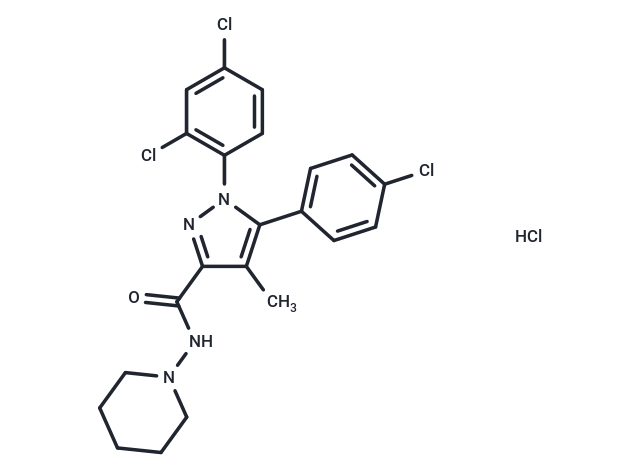Shopping Cart
- Remove All
 Your shopping cart is currently empty
Your shopping cart is currently empty

Rimonabant hydrochloride (SR 141716A) is a cannabinoid receptor antagonist, binding selectively to central cannabinoid receptors (CB1) with high affinity.

| Pack Size | Price | Availability | Quantity |
|---|---|---|---|
| 5 mg | $38 | In Stock | |
| 10 mg | $61 | In Stock | |
| 25 mg | $118 | In Stock | |
| 50 mg | $217 | In Stock | |
| 100 mg | $327 | In Stock | |
| 500 mg | $783 | In Stock | |
| 1 mL x 10 mM (in DMSO) | $68 | In Stock |
| Description | Rimonabant hydrochloride (SR 141716A) is a cannabinoid receptor antagonist, binding selectively to central cannabinoid receptors (CB1) with high affinity. |
| Targets&IC50 | CB1 receptor:1.8 nM(ki) |
| In vitro | Rimonabant hydrochloride (SR 141716A) binds selectively to central cannabinoid receptors (CB1) with high affinity (Ki=2 nM), and blocks the inhibitory effects of cannabinoid receptor agonists in the mouse vas deferens, dopamine-stimulated adenylyl cyclase and WIN 55212-stimulated GTPγS binding[1]. Rimonabant dose-dependently inhibited CO synthesis in Raw 264.7 macrophages, with 1 μM producing a significant (~40%) decrease compared to untreated controls and concentrations ≥ 5 μM producing near complete inhibition. A small, but significant, reduction of TG and DG synthesis is also observed with Rimonabant at concentrations ≥ 10 μM. Inhibition of CO synthesis in Raw 264.7 macrophages by Rimonabant (IC50 value 2.9±0.38 μM) is very similar to that of AM251 and SR144528 (IC50 value 2.6±0.26 μM and 2.5±0.32 μM, respectively), two related compounds previously demonstrated to be potent ACAT inhibitors. Mouse peritoneal macrophages also displayed significantly reduced CO synthesis in response to Rimonabant treatment. Rimonabant at concentrations ≥ 1 μM significantly inhibits CO synthesis in CHO-ACAT1 and CHO-ACAT2 cells in a concentration-dependent manner with similar efficiency (IC50s of 1.5±1.2 μM and 2.2±1.1 μM, respectively)[2]. |
| In vivo | Pretreatment with Rimonabant hydrochloride (SR 141716A) blocks the antinociceptive, discriminative stimulus, memory impairing and hypolocomotor effects produced by Δ-9-THC. SR 141716A also precipitates a withdrawal syndrome in rats treated chronically with Δ-9-THC[1]. Pretreatment of mice with 0.1?mg/kg of WIN 55212-2 is effective in increasing the CPP induced by MDMA , while 1?mg/kg of Rimonabant specifically blocks CB1 receptors and does not act as an inverse agonist[3]. |
| Kinase Assay | Raw 264.7 cells (2×106/well) in 12-well plates are rinsed with PBS and refed culture media supplemented with varying amounts of Rimonabant 1h prior to supplementation with 7-ketocholesterol (7KC). All wells are adjusted to receive equal amounts of vehicle. Following a 16 h incubation, caspase-3 and caspase 3-like activity is determined[2]. |
| Alias | SR 151716A, SR 141716A |
| Molecular Weight | 500.25 |
| Formula | C22H22Cl4N4O |
| Cas No. | 158681-13-1 |
| Smiles | n1(nc(c(c1c1ccc(cc1)Cl)C)C(=O)NN1CCCCC1)c1c(cc(cc1)Cl)Cl.Cl |
| Relative Density. | no data available |
| Storage | Powder: -20°C for 3 years | In solvent: -80°C for 1 year | Shipping with blue ice. | |||||||||||||||||||||||||||||||||||
| Solubility Information | DMSO: 60 mg/mL (119.94 mM), Sonication is recommended. | |||||||||||||||||||||||||||||||||||
Solution Preparation Table | ||||||||||||||||||||||||||||||||||||
DMSO
| ||||||||||||||||||||||||||||||||||||

Copyright © 2015-2025 TargetMol Chemicals Inc. All Rights Reserved.